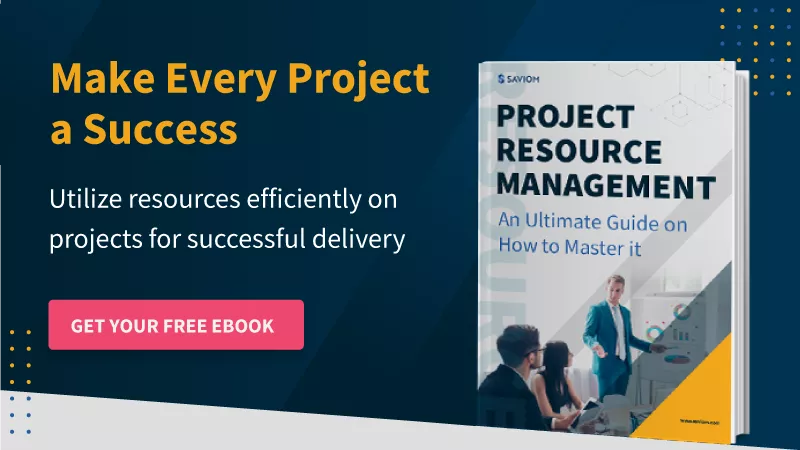Projects rarely progress smoothly throughout their lifecycle, as they often face challenges due to factors such as new requirements, scope adjustments, evolving market conditions, or other unforeseen circumstances. To effectively navigate these challenges and ensure a smooth transition, organizations require a structured approach to change management within their project management framework. This process reduces disruptions and ensures the project achieves its intended objectives.
In fact, according to a Prosci study, 88% of organizations with excellent change management programs meet or exceed project objectives.
Change management entails identifying, evaluating, and implementing changes while ensuring transparent communication with stakeholders and the project team. Additionally, it enhances team adaptability, minimizes resistance to change, and promotes a culture of collaboration. This approach helps organizations avoid budget and schedule overruns, ensure successful project delivery, and enhance client satisfaction.
This blog elucidates the fundamentals of change management in project management.
But let’s first understand what is change management.
What is Change Management in Project Management?
Change management is the process of planning, implementing, controlling, and monitoring changes within a project throughout its lifecycle. A well-defined process ensures the project stays aligned with its goals and prevents unexpected or drastic changes in the stipulated schedule or budget.
The primary objective of an effective change management strategy is:
- Assess each change request carefully.
- Process the change requests through proper approval channels.
- Communicate the impact of changes to the project stakeholders and the team.
- Implement changes and minimize their impact on the overall budget and schedule.
Example of Change Management in Project Management
Let’s consider a software development team working on a mobile app that initially focuses on basic user functionality. Midway through the project, the client requests to integrate advanced AI capabilities, such as personalized recommendations and voice commands. This significant change in scope could potentially disrupt the project if not managed effectively.
To address this, the project manager follows a structured change management process. They start by working closely with key stakeholders, including the client, development team, and change control board, to conduct a comprehensive assessment of the new requirements. This thorough process involves analyzing the technical feasibility of integrating AI, estimating the additional time and budget required, and identifying potential risks to the original project objectives.
Once the project manager receives approval from CCB, they revise the project plan to include the new timeline, scope, and budget. Then, they secure approval to acquire additional resources, such as AI specialists and new tools. Moreover, they maintain regular communication to keep the team and stakeholders informed and aligned, ensuring a shared commitment to the updated goals.
This example highlights how effective change management enables project teams to adapt to new demands and deliver successful outcomes.
In the next section, let’s understand the different types of change management in project management.
Types of Change Management
The change management process can be categorized into four categories:
Anticipatory
Anticipatory changes are planned or expected changes that allow a project manager to prepare and plan for future challenges before they arise. This process is similar to implementing risk mitigation strategies or contingency plans to prevent any significant project changes and ensure you stay ahead of the curve.
Reactive
Reactive changes involve resolving unforeseen issues or modifications without prior planning. Instances like sudden stakeholder demands outside the original scope require a reactive approach to handle the situation. In these cases, project managers leverage their expertise to address issues as they arise and ascertain that the project stays on track despite disruptions.
Incremental
Incremental change is a gradual approach where substantial changes are broken into small, manageable steps over time. This approach can help reduce employee resistance, allowing team members to adapt to this change steadily instead of facing abrupt, overwhelming adjustments. It ensures a seamless transition and consistent progress towards the organization’s goals.
Strategic
It’s a large-scale change that impacts the entire organization and is often driven by dedicated change management teams. It involves realigning the organization’s resources, policies, and operations to meet its long-term goals, adapt to market shifts, or improve performance.
Now that we know the different types of change management, let’s explore prominent models used for managing changes.
Read More: How Can You Improve Organizational Change Management Strategies?
Change Management Models
Change management models provide structured frameworks for planning, implementing, and monitoring change requests. Below is the list of some of the most prevalent models:
The ADKAR Model
Developed by Prosci founder Jeff Hiatt, the ADKAR model is a goal-oriented framework for managing individual change. It demonstrates five key elements: Awareness of the need for change, Desire to support the change, Knowledge of how to implement it, Ability to apply desired skills and behaviors, and Reinforcement to sustain the change over time. These elements work together to ensure successful adoption and strategic impact.
Kotter’s 8-step process
Dr. Kotter’s 8-step model prioritizes creating a sense of urgency and getting leadership buy-in to drive successful change. It involves developing a clear vision and strategy and effectively communicating it with the project team. The following steps focus on removing barriers, enlisting support, and achieving quick wins to build momentum. Finally, the model ensures long-term project success by sustaining progress & instituting relevant change.
Lewin’s Change Management Model
Lewin’s three-step model—unfreeze, change, refreeze—uses the analogy of an ice cube to explain change. The first step, Unfreeze, involves breaking the existing status quo to prepare for new methods. The next step is to implement the change and experience improvements. Refreeze, the final stage, focuses on stabilizing and sustaining the new processes.
McKinsey 7-S Model
Developed by Robert H. Waterman Jr. and Tom Peters, this model breaks a change program into seven interconnected factors—Strategy, defining company goals & plans; Structure, outlining roles & hierarchy; Systems, encompassing tools and processes; Shared values, guiding principles and culture; Skills, reflecting employee expertise; Style, representing leadership approaches; and Staff, the workforce and their roles—to ensure alignment and smooth transitions.
Bridges’ Transition Model
William Bridges, a change consultant, created this model to highlight employees’ emotional journey during transitions. The process follows three stages: discontinuing the old method, navigating a neutral zone of uncertainty and confusion, and finally accepting the new change. The model helps project managers address resistance and guide the team toward successful change implementation.
PDCA Cycle (Plan-Do-Check-Act)
The PDCA Cycle, also known as the Deming Cycle, is a continuous improvement model that emphasizes iterative problem-solving and process optimization. It consists of four phases: Planning to identify and address issues; Doing changes on a small level; Checking phase involves monitoring progress; and then Acting accordingly.
Prosci Change Management Framework
The Prosci Change Management Framework is a comprehensive approach designed to guide organizations through changes. It includes three phases: preparing the change, where a tailored change management strategy is developed. The next phase is managing the change by creating and implementing actionable plans. Lastly, reinforcing the change by ensuring its successful adoption by the team.
Nudge Theory
Like its name, the theory relies on evidence-based, subtle, and indirect suggestions to guide employees toward desired changes. Its basic principles are defining the change, considering employees’ points of view, providing proof of its validity, presenting it as optional, prioritizing employee feedback, limiting options, and highlighting short-term wins to solidify the change.
Read More: The Fundamentals of Leadership in Project Management
Now that we have understood the varying change management models. Let’s acknowledge the rewarding benefits of change management in project management.
Benefits of Change Management in Project Management
A structured change management process improves existing practices, ensures seamless shifts, and keeps all team members aligned. Listed below are its key advantages.
Streamlines Process Improvement
Change management facilitates process improvements by allowing project managers to develop clear frameworks for implementing new protocols or procedures. For instance, the PDCA change management model can ensure the changes are introduced in a controlled manner by allowing careful planning, execution, monitoring, and adjustment as needed. This systematic approach minimizes disruptions and ensures consistent improvement.
Enables the Workforce to Adapt to the Change
A robust change management strategy helps individuals understand the rationale behind changes and equips them to adapt effectively. It informs employees about upcoming changes and provides the necessary knowledge and skills to succeed in evolving circumstances. Moreover, it fosters enhanced employee productivity and ensures timely project execution.
Read More: 10 Effective Ways to Increase Employee Productivity in the Workplace
Reduces Variability in Project Constraints
Effective change management ensures that new requirements are meticulously evaluated before implementation, preventing scope creep. It helps assess the impact of changes on project constraints such as timelines, resources, and budget, enabling informed decision-making. By minimizing unexpected fluctuations, change management keeps the project aligned with its original objectives.
Mitigates Project and Resource-Related Risks
Change management provides a structured approach to assessing and mitigating project and resource-related risk. It allows project managers to identify critical resources and evaluate their availability, reducing the likelihood of shortages and missed deadlines. Additionally, it facilitates the creation of contingency plans to address potential issues and ensure smooth workflow.
Read More: How to Mitigate Resource Risk in Project Management?
Allows Scope Freezing for Better Control
A structured approach to managing changes allows for scope freezing when necessary. This limits excessive changes that could hinder the project’s progress. By controlling scope creep, project teams can focus on implementing the change request efficiently, ensure timely delivery, and avoid cost overruns or resource shortages. Therefore, scope freezing ensures projects stay on track and deliver intended outcomes.
Enhances Cross-Functional Collaboration
Change management fosters cross-functional collaboration by bringing together individuals from different teams and departments to work on the project changes. This collaborative approach ensures that everyone understands the change requests and its necessity, reducing silos, resistance, and confusion. Moreover, improved collaboration leads to better alignment and more effective teamwork toward common objectives.
Read More: 10 Ways to Improve Cross-Departmental Collaboration
Let’s gain deep insights into effectively implementing change management to expedite project delivery and minimize schedule overruns.
How to Implement Effective Change Management in Project Delivery?
Effective change management requires tailored strategies that address the unique challenges of project management. Below is a detailed guide to steps that can be taken to ensure successful change management.
Define the Change and Its Objectives
The first step in managing change is clearly defining the change request. This involves identifying the specific adjustments or modifications required within the project. Understanding the scope, goals, and expected outcomes of the change is essential to ensuring alignment with the project’s overall objectives.
Once the change is defined, the objectives must be established. It should be specific, measurable, and achievable. These objectives will serve as a guiding framework for the change process, ensuring that the changes lead to desired improvements and outcomes.
Conduct a Change Impact Assessment
The next step is to conduct a change impact assessment, which involves evaluating how the proposed change will affect various project elements such as scope, timelines, budget, resources, and team dynamics. This assessment should be comprehensive, considering both the immediate and long-term effects.
In addition, it should consider external stakeholders and their interests. The evaluation must also prioritize the changes based on their significance and potential for disruption, which provides a roadmap for systematically addressing each change. Consequently, it enables project managers to make informed decisions and prepare the team for the adjustments required.
Read More: Six Project Constraints and Ways to Manage Them
Engage Project Team and Stakeholders
At this stage, the project manager should communicate with team members, stakeholders, and anyone affected by the change to ensure their involvement and buy-in. This engagement should begin early to build trust and allow the team to provide input on how the change might affect their work.
On the other hand, project stakeholders must be engaged actively in the decision-making process where applicable. Managers must solicit their feedback and promptly ensure their needs and expectations are met. This cohesion increases the likelihood of successful change implementation.
Develop a Communication Plan
Next, the project manager must develop a detailed communication strategy that outlines how the changes will be conveyed to all stakeholders. This plan should include the types of messages to be shared, the channels to be used, and the frequency of communication. It is essential to ensure that the messages are tailored to different audiences, addressing their concerns and interests.
The communication plan should also define who is responsible for delivering the messages and how feedback will be collected. This ensures that information flows smoothly and consistently, minimizing misunderstandings and confusion. Additionally, project managers can leverage robust collaboration tools to streamline the communication process.
Provide Training and Support
In this step, the project manager should identify any new skills or knowledge the team needs to implement the change effectively. This could involve training sessions, workshops, shadowing opportunities, etc., that help employees adapt to new tools, processes, or methodologies.
By ensuring that team members are adequately trained, project managers can mitigate the risk of errors or inefficiencies caused by unfamiliarity with the new systems. In addition, access to continuous resources, including expert consultations, documentation, and troubleshooting support, can ensure that team members can seek help when needed and remain confident in their ability to carry out their tasks.
Read More: How Can Retraining/Upskilling Future-Proof Your Workforce?
Establish a Timeline and Milestones
Project managers must establish a timeline that accounts for the complexity of the change request and allocate sufficient time for each phase, including planning, execution, and review. The timeline should also include buffer periods to accommodate any unforeseen delays or bottlenecks that may impact the project’s progress.
Then, they must set and track project milestones to assess whether the change is proceeding as planned. Each milestone should represent a significant achievement or decision point, allowing the team to evaluate progress and identify discrepancies in real-time.
Monitor Progress and Make Necessary Adjustments
Once the change implementation begins, the project manager must continuously monitor quantitative metrics such as timelines, resource utilization, cost, and team performance. In case deviations occur, they should make necessary adjustments to mitigate the impact on the overall project schedule/budget.
In addition, they can seek qualitative feedback from the team and stakeholders to understand how the change is being received and whether it is meeting the desired goals. This feedback allows for further refinement. Moreover, managers can hold regular progress meetings to inform all parties about the current status.
Review and Document the Process
The final step in the change management strategy is to review and document the entire process. After the request has been fully implemented, the project manager should conduct a thorough review of how the change was managed and evaluate its success based on the objectives set at the beginning of the process.
It should also include the challenges faced during the implementation and the effectiveness of the strategies used to mitigate them. Moreover, documenting the change management process is critical for future reference and continuous improvement. It prevents the team from committing the same mistakes and optimizes future project delivery.
The following section highlights change management best practices that organizations can implement to improve their internal processes.
Change Management Best Practices That Project Managers Must Know
Here are some proven methods for effective change management:
Use a Structured Methodology to Implement the Change Requests
A structured methodology ensures that all change requests are handled consistently and efficiently. Project managers should adopt a formal process for submitting, reviewing, and approving changes. This includes documenting the change request, assessing its impact, and evaluating its alignment with project objectives.
Read More: What are the Different Project Management Methodologies?
Facilitate Open Dialogue Among Project Stakeholders
Open dialogue is essential for ensuring that project stakeholders are informed and involved in the process. Project managers should create regular opportunities for clients to voice concerns, ask questions, and provide feedback. This can be achieved through meetings, surveys, or collaborative platforms.
Encourage Employees to Participate in the Process
Engaging employees in the change process fosters a sense of ownership and accountability. Managers should actively involve team members by soliciting their input on how changes affect their roles and project workflows. They can encourage participation through workshops, feedback sessions, or pilot programs where employees can freely voice their opinions.
Read More: 11 Effective Strategies to Enhance Employee Engagement
Prepare for Resistance and Manage it Effectively
Resistance to change is innate. Hence, it’s vital to address it with empathy and strategic interventions. Managers must try to understand the root causes of opposition, offer support by clarifying the change, and provide training to mitigate disruptions.
Leverage Technology for Better Change Control
Technology can streamline and enhance change control processes by providing tools for tracking, managing, and documenting modifications. Organizations can utilize project management software to optimize their entire change management framework. These tools offer features like real-time task tracking, documentation management, a collaboration platform, and more that help managers monitor and control project changes.
Read More: How Can You Make Data-Driven Decisions with Resource Management Software?
The Takeaway
Change is inevitable in any project, and without a strong framework in place, it can derail progress. Therefore, change management in project management plays a crucial role in navigating the complexities of evolving project requirements, stakeholder expectations, and external factors. By applying effective aforementioned strategies, organizations can ensure that change requests are successfully addressed within projects.
Have you implemented any of these change management models yet?
The Glossary
Read More: Glossary of Resource Workforce Planning, Scheduling and Management












